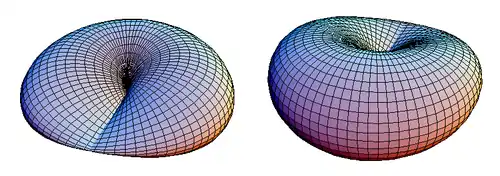Cross-cap
In mathematics, a cross-cap is a two-dimensional surface in 3-space that is one-sided and the continuous image of a Möbius strip that intersects itself in an interval. In the domain, the inverse image of this interval is a longer interval that the mapping into 3-space "folds in half". At the point where the longer interval is folded in half in the image, the nearby configuration is that of the Whitney umbrella.

The interval of self intersection precludes the cross-cap from being homeomorphic to the Möbius strip, but there are only two points in the image (the endpoints of the interval of self-intersection) where the image cannot be that of an immersion. The bounding edge of a cross-cap is a simple closed loop. Like certain versions of the Möbius strip, it may take the form of a symmetrical circle.
A cross-cap that has been closed up by gluing a disc to its boundary is a model of the real projective plane P2 (again with an interval of self-intersection, and two points where this model is not an immersion of P2).
Two cross-caps glued together at their boundaries form a model of the Klein bottle, this time with two intervals of self-intersection and four points where this model is not an immersion.
An important theorem of topology, the classification theorem for surfaces, states that each two-dimensional compact manifold without boundary is homeomorphic to a sphere with some number (possibly 0) of "handles" and 0, 1, or 2 cross-caps.
